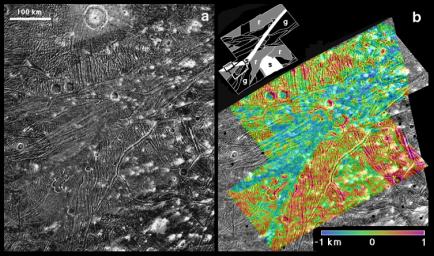These two frames, derived from images of Jupiter's moon Ganymede by NASA's Galileo and Voyager spacecraft, show bright terrain types and topography within an area called Sippar Sulcus in Ganymede's southern hemisphere. All three dominant structural styles of the bright regions—grooved terrain, smooth terrain and reticulate terrain—are represented.
The left frame (a) is a mosaic of images taken by Galileo with a resolution of 180 meters (590 feet) per pixel superimposed on lower-resolution Voyager images. A swath of smooth terrain crosses the scene diagonally from upper right to center left. Irregularly shaped enclosures are interpreted as calderas, which, on Earth, are depressions typically caused by collapse of subsurface lava reservoirs. The numerous bright patches are due to secondary impacts from creation of a large crater, Osiris, which is out of the frame to the right.
The right frame (b) shows a digital elevation model of the three-dimensional shape of the same scene. Relative elevation values have been color-coded and merged with the Galileo image mosaic. The inset shows a geological map highlighting areas of grooved terrain (g, black), reticulate terrain (r, gray), smooth terrain (s, white), calderas (hatched), and locations for higher-resolution views PIA-XXC [fig3a] (upper box) and PIA-XXD [fig3b] (lower box).
These images were prepared by the Lunar and Planetary Institute, Houston, and included in a report by Dr. Paul Schenk et al. in the March 1, 2001, edition of the journal Nature.
The Jet Propulsion Laboratory, a division of the California Institute of Technology in Pasadena, manages the Galileo and Voyager missions for NASA's Office of Space Science, Washington, D.C.
Images and data received from Galileo are posted on the Galileo mission home page at http://www2.jpl.nasa.gov/galileo/. Background information and educational context for the images can be found at http://www2.jpl.nasa.gov/galileo/sepo/.

 Planetary Data System
Planetary Data System












